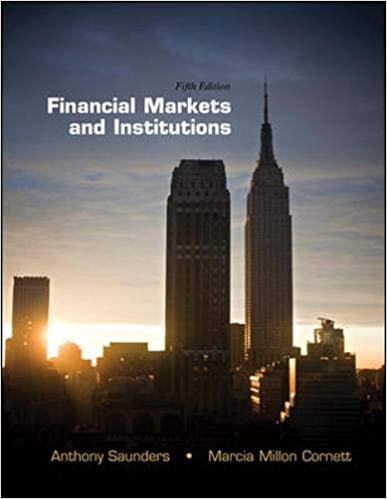Question
What is the most expensive source of capital according to the pecking order theory? Retained earnings Debt Preferred stock Common stock Flag this Question Question
What is the most expensive source of capital according to the pecking order theory?
| Retained earnings |
| Debt |
| Preferred stock |
| Common stock |
Flag this Question
Question 28.34 pts
Which of the following statements about NPV and IRR is least accurate?
| The IRR is the discount rate that equates the present value of the cash inflows with the present value of outflows. |
| For mutually exclusive projects, if the NPV method and the IRR method give conflicting rankings, the analyst should use the IRRs to select the project. |
| The NPV method assumes that cash flows will be reinvested at the cost of equity, while IRR rankings implicitly assume that cash flows are reinvested at the IRR. |
| None of the above |
Flag this Question
Question 38.34 pts
Consider a project with the following cash flows -100, 230 and -134 at time 0, 1 and 2, respectively. Obtain the IRR(s) of the project.
| 10% and 20% |
| 10% |
| 20% |
| IRR does not exist |
Flag this Question
Question 48.34 pts
Consider a project with an initial outlay of $1,000 and yearly cash flows as follows: -200, -100, 300, 300, 300, 100, 100, 200, 700, 400, and 100. Calculate the classical payback period assuming 10% cost of funds.
| 8 |
| 8.5 |
| 9 |
| 9.75 |
Flag this Question
Question 58.33 pts
Let a project costing $250,000 generate level cash flows of $40,000 at the end of each year for 10 years. If the scrap value of the project is $80,000, calculate the IRR on the project.
| 9.61% |
| 12.15% |
| 30.03% |
| 10.25% |
Flag this Question
Question 68.33 pts
Consider a project with the following cash flows -100, 230 and -134 at time 0, 1 and 2, respectively. Obtain the PI (Profitability Index) of the project if the cost of capital is 10%.
| 0.99 |
| 1.01 |
| 1.03 |
| 1.05 |
Flag this Question
Question 78.33 pts
Consider a project with the following cash flows -100, 230 and -134 at time 0, 1 and 2, respectively. Obtain the NPI (Net Profitability Index) of the project if the cost of capital is 10%.
| 0.0078 |
| 0.0084 |
| -0.0078 |
| -0.0084 |
Flag this Question
Question 88.33 pts
Efeyeyou Corp. is considering a project that will require an initial investment of $130,000 and will return level cash flows of $14,000 for 30 years. Compute the NPV assuming k=.1.
| 1,976.80 |
| 2,000.00 |
| 2,159.80 |
| -7450.11 |
Flag this Question
Question 98.33 pts
If the RTY Corporation follows CAPM and has a beta of 2.0, and the market and risk-free rate of return are 14 and 8 percent, respectively. Obtain the cost of equity capital for the RTY Corporation.
| 6% |
| 14% |
| 20% |
| 22% |
Flag this Question
Question 108.33 pts
If the IOP Corporation follows CAPM and the market and risk-free rate of return are 15 and 7 percent, respectively. Obtain the firms beta, assuming that the cost of equity capital is 11 percent.
| 1.5 |
| 2.5 |
| 1.0 |
| 0.5 |
Flag this Question
Question 118.33 pts
Compute the yield to call for the FGH Company bond maturing in 10 years (7 percent coupon rate and a face value of $1,000) with the call provision of "after 7 at 115" and a market price of 995.
| 8.74% |
| 8.76% |
| 8.78% |
| 8.80% |
Flag this Question
Question 128.33 pts
Compute the weighted average cost of capital (WACC) if the cost of debt before multiplying it by a tax factor is 6%, the cost of equity is 10%, the corporate tax rate is 35%, the market value of the firms debt is $120 million, and the market value of the firms equity is $180 million.
| 6.00% |
| 7.56% |
| 8.40% |
| 10.00% |
Step by Step Solution
There are 3 Steps involved in it
Step: 1

Get Instant Access to Expert-Tailored Solutions
See step-by-step solutions with expert insights and AI powered tools for academic success
Step: 2

Step: 3

Ace Your Homework with AI
Get the answers you need in no time with our AI-driven, step-by-step assistance
Get Started


